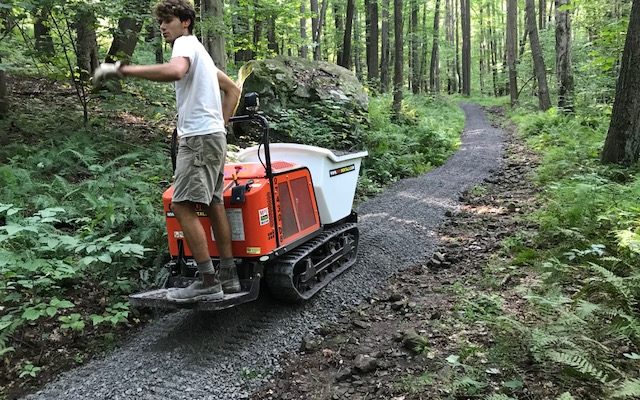by Adam Polinski



Two big days of work in August, 2018, catapulted the upgrade of the “campground hill” section of Scott Run Trail from 50% to 90% completed.
The focus of this particular project on Scott Run Trail has been to tackle the poorly-drained, overgrown, and extremely rough trail surface of the quarter-mile southern end of Scott Run Trail – the end closest to McCollum Campground. The goals have been to cut back brush, fix all drainage problems so that the trail drains quickly and completely, and overlay a part of the trail bed (which is actually a very old, rocky road) with a shaped, raised bed of highly-compactable, recreation-friendly crusher run gravel. The addition of the raised bed of crusher run will make the segment of trail a drier, smoother, and more reasonable undertaking for hikers, trail runners, mountain bikers and cross-country skiers.
Moving over 50 tons of compactable gravel from a nearby parking lot, down onto the trail, and placing it in the narrow 42” width accorded by the design of the project, has been no easy task. Tons and tons of crusher run was delivered onto the upper half of the project area manually, using wheelbarrows and bucket brigades, in part by CRF but mostly with the huge helping hand of dozens of volunteers – thank you, ALL! But as the working edge of the project became progressively farther and farther away from the gravel source, the task became prohibitively hard to continue manually, so machines entered the equation.
Mountain Valley Resources came into the game to assist CRF, and really delivered. In one day, over 30 tons of crusher run was placed along the entire lower half of the linear project area. MVR showed up with a front-end loader on a flatbed trailer, a dump truck full of even more crusher run than we already had, and another trailer hauling what proved to be two pieces of crucial machinery. The decision to rent a couple of ‘concrete buggies’ – built to deliver concrete into hard-to-reach places on a construction site – was a game-changer. Running on treads instead of wheels, these vehicles, operated by standing on back of them much like some large lawnmowers are operated, were able to transport over 1,000 pounds per lap, between the gravel pile in the parking lot and the working edge of the project. Additionally, driving these tread-equipped vehicles back up the freshly-dumped gravel helped compact the gravel into place.
Just four days later, CRF welcomed a busload of incoming WVU Freshmen trail work volunteers, who signed up for Community Service at Coopers Rock as part of WVU’s Welcome Week. They got to see a little bit of Coopers Rock before they even set foot in the classroom! This crew of students worked up and down the entire 800’ lower section of the “campground hill” upgrade. They took what was a roughed-out raised bed of crusher run, and refined it to a point where it is in final form everywhere except the drainage crossings. The student volunteers used bow rakes to move around and shape the crusher run, shovels to re-shape drainage features that had been impacted from multiple trips over them by the ‘gravel buggies’, and tampers to compact (and therefore harden) the gravel. Crusher run has gravel particles of varying sizes as well as coarse sand, and when it is tamped, crusher run gravel compacts into a very hard surface, much different from driveway gravel, which, by design, never compacts. The students also stamped and stomped on the gravel, acting as human steamrollers, using their weight to compact the surfacing material.
The arrangements for bringing to Coopers Rock this very helpful crew of college students were courtesy of WVU’s Center for Service & Learning. The CS&L has provided to CRF a busload or two of student volunteers as part of Welcome Week for the past 6 or 7 years. These contributions of volunteers every August, and many others that CS&L has coordinated, have done a great deal to help CRF do good works around the State Forest.
The 90% complete status of the “campground hill” segment of Scott Run Trail is that it is well-drained and completely useable or foot travel and mountain bikes. The remaining 10% of work is very important, however. Each drainage crossing, and there are well over a dozen, will be carefully shaped and angled, to make the drainage feature gentle and rolling, rather than steep and abrupt. The final shape of each feature, where it crosses the trail bed, will comfortably accommodate walkers, runners, mountain bikers, and cross-country skiers, travelling in both directions. This work is planned to be complete in September, 2018.

